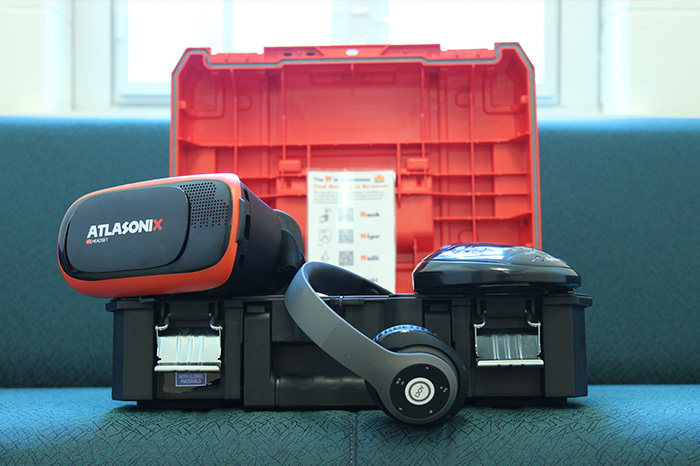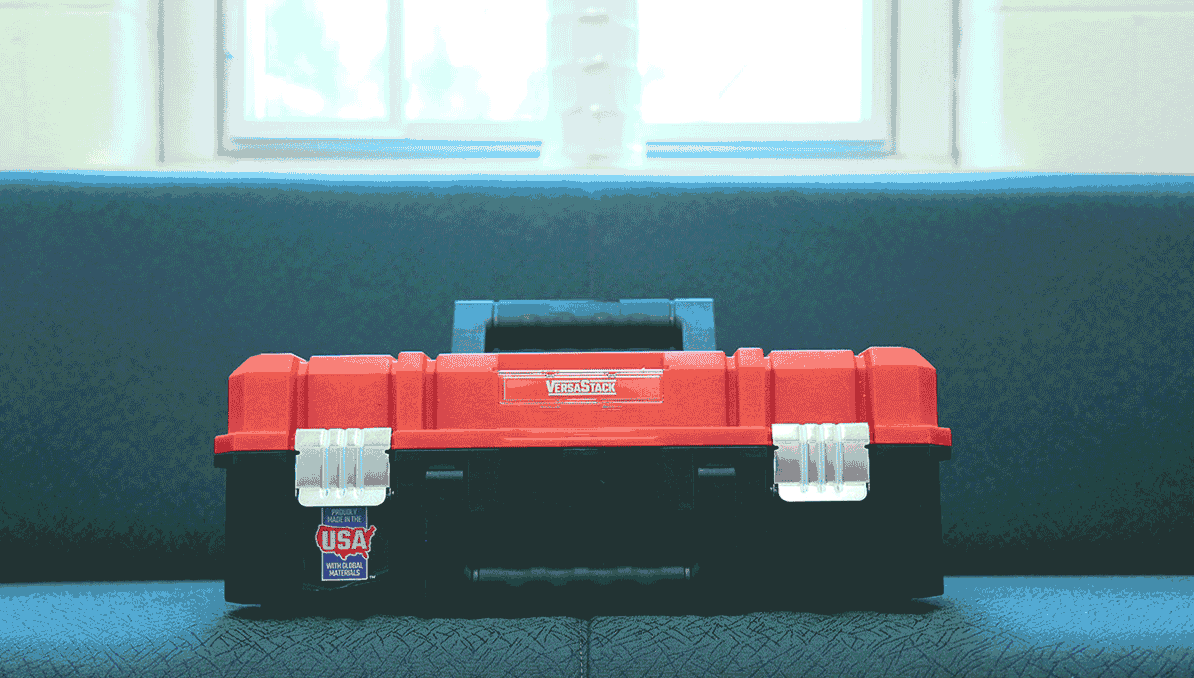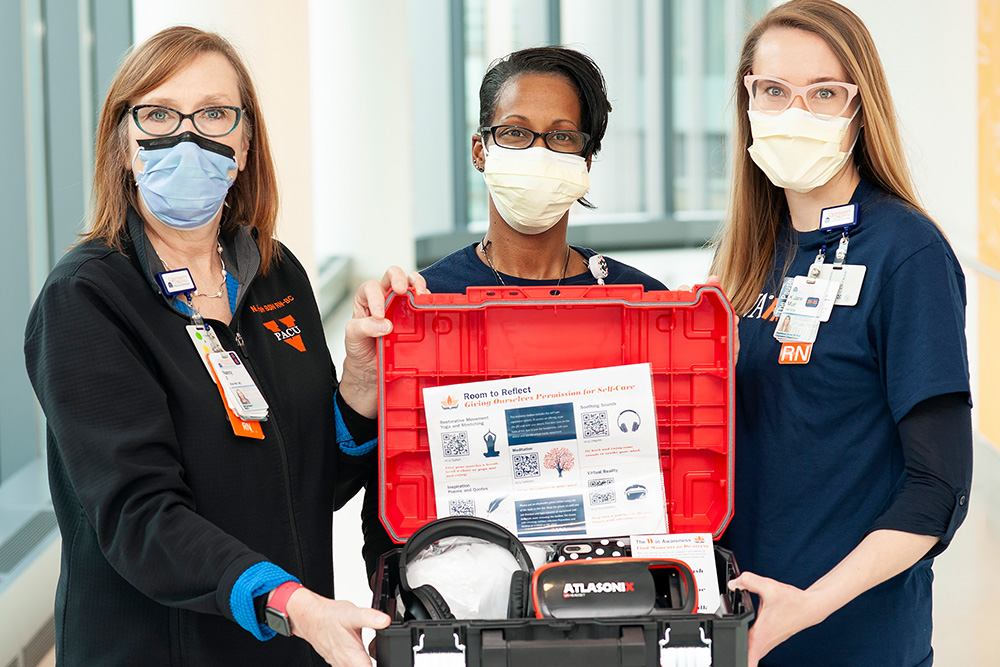
Toolbox Timeout
When the pandemic struck and hospital break rooms were unexpectedly repurposed—
—due both to a deluge of ill patients and bulky COVID-19-related gear—a trio of UVA Health nurses put their heads together to find a way for clinicians caring for patients to take a breather during a shift.
Now, two years later, the first results of their “resilience toolbox”—a mobile assortment of sound machines, VR headsets, and short guided mindfulness activities that nurses can do while they work or in between patients when they need a moment to themselves—are in.


"Our findings establish that RNs are interested in and can use technology that efficiently helps them restore in the workplace. Resilience is a skill that can be learned."
Nancy Farish, Jane Muir, and Jeanell Webb-Jones, nurse inventors and creators of "Room to Reflect" toolbox
In mid-2021, UVA Health nurses Nancy Farish, Jane Muir (BSN `12, MSN `22, PhD `22), and Jeanell Webb-Jones deployed an on-unit resilience toolbox called “Room to Reflect” across seven hospital units and to 57 nurses and nurse managers for a series of two-month trials. The toolboxes—which contained a variety of audio visual and mindfulness guide resources (including a sound machine, poetry, guided visualizations, virtual reality headsets with video escapes, and a pocket guide to mindfulness activities while working)—were distributed across inpatient, outpatient, pre-operative, and post-operative settings. Participants could access the resources both using the toolbox and through quick-response (QR) codes.
Participants’ baseline resilience scores were assessed prior to using the interventions, and then again at the end of the study, along with open-ended questions about the toolboxes’ impact, barriers encountered while using them, and their accessibility.
- [LISTEN] "Helping stressed out nurses relax" (NPR/WVTF Radio IQ)
In all, 50 staff nurses and seven nurse managers accessed the toolboxes’ five categories of offerings. While mean resilience scores increased marginally in aggregate (from 28.4 to 29.7), there were more significant increases in resilience scores among more experienced nurses (29.6 to 31.6) and nurse managers (28.5 to 30). Nurse managers also reported that the intervention improved their RN staffs’ stress management and job satisfaction. The study is published in the latest issue of the International Journal of Environmental Research in Public Health.
“Our findings establish that RNs are interested in and can use technology that efficiently help them restore in the workplace,” the authors write. “Resilience is a skill that can be learned.”
"Unit RNs are drawn to use resiliency practices when they are encouraged by their leadership to do so."
Nurses Farish, Muir, and Webb-Jones, in the International Journal of Environmental Research in Public Health
Before the pandemic, burnout rates among nurses were already high, impacting nearly one-third of American nurses in 2020. Today, as the pandemic enters its third year, up to 55 percent of nurses in the U.S. and around the world report burnout, and post-traumatic stress rates remain high.
“Unit RNs are drawn to use resiliency practices when they are encouraged by leadership to do so,” the authors write.
Nurses that report higher levels of resilience are less likely to be burned out, offer superior, higher quality care, and cost hospital systems less because they make fewer errors, and are less likely to leave the profession.
Since the pandemic, increasing numbers of hospitals are recognizing these facts, and have created positions for chief wellness officers, wellbeing rooms on unit, lavender rooms, and stress reduction interventions, and recommitted to mandating safe and sufficient RN staffing rations to reduce burnout. Health systems, say the authors, must recognize that reducing burnout requires organizations to share responsibility with RNs, unit leaders, and system leadership.
Since the pandemic, increasing numbers of hospitals are recognizing these facts, and have created positions for chief wellness officers, wellbeing rooms on unit, lavender rooms, stress reduction interventions, and recommitted to mandating safe and sufficient RN staffing rations to reduce burnout. Health systems, say the authors, must recognize that reducing burnout requires organizations to share responsibility with RNs, unit leaders, and system leadership.
The “Room to Reflect” toolboxes’ pocket guide with guided mindfulness prompts (which included guided activities across the four Ws of awareness: walking, wiping, washing, and waiting) proved to be the most used intervention, followed by soothing sounds audio (low frequency music, nature sounds, and guided relaxation exercises) and the VR headset (soothing nature videos). More than 85 percent of managers in the study encouraged staff verbally to take time for themselves but attributed high patient acuity as a significant barrier to supporting their staff. Over the two-month pilot, most nurses used the toolkits’ contents between one and five times.
“A plethora of studies identify that resilience buffers the impact of occupational stress, reduces the risk of burnout, and enhances social connections on the job,” the authors write. “[R]egistered nurses seek resiliency practices not only for personal well-being but professional development. Such findings have positive implications for the quality of patient care and delivery.”

